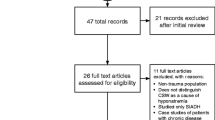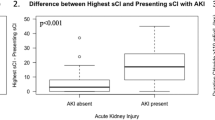Abstract
The objective of this study was to analyze the clinical features of brain trauma associated syndrome of inappropriate antidiuretic hormone secretion. A retrospective analysis was performed for the electrolytes and osmolality of blood and urine samples of brain injury patients, which have been collected in our department since last 20 years. Four cases of brain injury patients met the criteria of SIADH, and three of them were cured but one patient died. In conclusion, the pathogenesis and treatment of SIADH associated with brain injury are different from hyponatremia. Early diagnosis and treatment can reduce the morbidity and mortality of patients with traumatic brain injury.
Similar content being viewed by others
References
Bartter, F. C., & Schwartz, W. B. (1967). The syndrome of inappropriate secretion of antidiuretic hormone. American Journal of Medicine, 42(5), 790–806.
Schwartz, W. B., Bennett, W. C., Curelop, S., & Bartter, F. C. (1957). A syndrome of renal sodium loss and hyponatremia probably resulting from inappropriate secretion of antidiuretic hormone. American Journal of Medicine, 23, 529–542.
Damaraju, S. C., Rajshekhar, V., & Chandy, M. J. (1997). Validation study of a central venous pressure-based protocol for the management of neurosurgical patients with hyponatremia and natriuresis. Neurosurgery, 40, 312–317.
Baylis, P. H., & Cheetham, T. (1998). Diabetes insipidus. Archives of Disease in Childhood, 79, 84–89.
Van Amelsvoort, T., Baskshi, R., Devaux, C. B., et al. (1994). Hyponatraemia associated with carbamazepine and oxcarbamazepine therapy: A review. Epilepsia, 35, 181–188.
Mewasingh, L., Aylett, S., Kirkham, F., et al. (2000). Hyponatraemia associated with lamotrigine in cranial diabetes insipidus. Lancet, 356, 656.
Zafonte, R. D., & Mann, N. R. (1997). Cerebral salt wasting syndrome in brain injury patients: a potential cause of hyponatraemia. Archives of Physical Medicine and Rehabilitation, 78, 540–542.
Graziani, G., Cucchiari, D., Aroldi, A., Angelini, C., Gaetani, P., & Selmi, C. (2012). Syndrome of inappropriate secretion of antidiuretic hormone in traumatic brain injury: When tolvaptan becomes a life saving drug. Journal of Neurology, Neurosurgery, and Psychiatry, 83(5), 510–512.
Watabe, R., et al. (2000). Angiotropic B-cell lymphoma with hemophagocytic syndrome associated with syndrome of inappropriate secretion of antidiuretic hormone. Annals of Hematology, 799(10), 581–584.
Levy, M. L. (1997). Comment on “Validation study of a central venous pressure-based protocol for the management of neurosurgical patients with hyponatremia and natriuresis”. Neurosurgery, 40, 17.
Lohani, S., & Devkota, U. P. (2011). Hyponatremia in patients with traumatic brain injury: Etiology, incidence, and severity correlation. World Neurosurgery, 76(3–4), 355–360.
Costa, K. N., Nakamura, H. M., da Cruz, L. R., de Miranda, L. S., dos Santos-Neto, R. C., Cosme, Sde. L., et al. (2009). Hyponatremia and brain injury: Absence of alterations of serum brain natriuretic peptide and vasopressin. Arq Neuropsiquiatr, 67(4), 1037–1044.
Sherlock, M., O’Sullivan, E., Agha, A., Behan, L.-A., Owens, D., Finucane, F., et al. (2009). Incidence and pathophysiology of severe hyponatraemia in neurosurgical patients. Postgraduate Medical Journal, 85(1002), 171–175.
Macias-Robles, M.-D., Lopez-Fonticiella, M.-P., Macia-Bobes, M., & Fernandez-San-Martin, A. (2009). Severe and acute hyponatremia in a schizophrenic patient with potomania. Anales del Sistema Sanitario de Navarra, 32(1), 117–120.
Chang, C.-H., Liao, J.-J., Chuang, C.-H., & Lee, C.-T. (2008). Recurrent hyponatremia after traumatic brain injury. The American Journal of the Medical Sciences, 335(5), 390–393.
Lu, D.-C., Binder, D.-K., Chien, B., Maisel, A., & Manley, G.-T. (2008). Cerebral salt wasting and elevated brain natriuretic peptide levels after traumatic brain injury: 2 case reports. Surgical Neurology, 69(3), 226–229.
Moro, N., Katayama, Y., Igarashi, T., Mori, T., Kawamata, T., & Kojima, J. (2007). Hyponatremia in patients with traumatic brain injury: incidence, mechanism, and response to sodium supplementation or retention therapy with hydrocortisone. Surgical Neurology, 68(4), 387–393.
Acknowledgments
The authors thank Ms. Hong Tang and Ms. Wei Sun for their assistance in data collection.
Author information
Authors and Affiliations
Corresponding author
Additional information
Contribution of Authors
Lizhao Chen, Minhui Xu, Yongwen Zou, and Lunshan Xu collected the study cases and performed SIADH diagnosis. Lizhao Chen was responsible for writing the paper under the direction of Lunshan Xu.
Rights and permissions
About this article
Cite this article
Chen, L., Xu, M., Zou, Y. et al. Clinical Analysis of Brain Trauma-Associated SIADH. Cell Biochem Biophys 69, 703–706 (2014). https://doi.org/10.1007/s12013-014-9856-0
Published:
Issue Date:
DOI: https://doi.org/10.1007/s12013-014-9856-0




